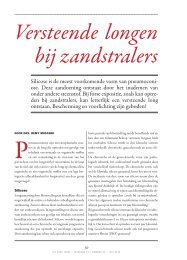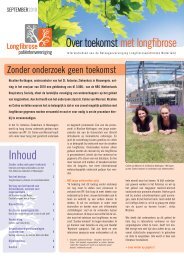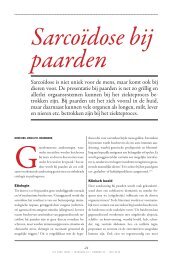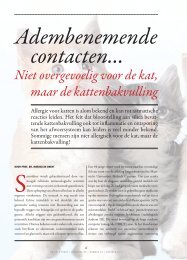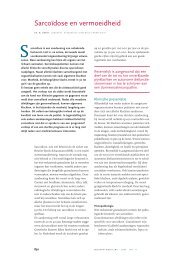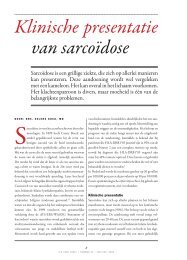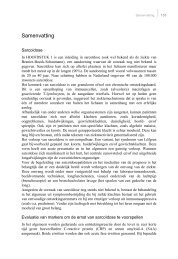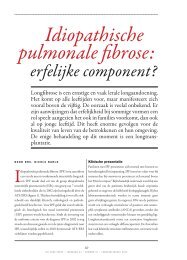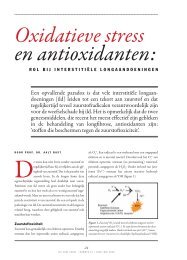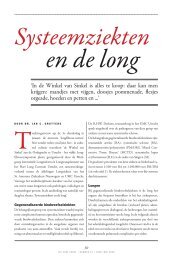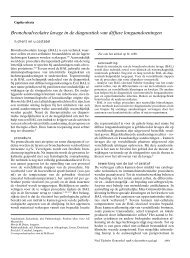Interpretation of bronchoalveolar lavage fluid cytology - ILD care
Interpretation of bronchoalveolar lavage fluid cytology - ILD care
Interpretation of bronchoalveolar lavage fluid cytology - ILD care
Create successful ePaper yourself
Turn your PDF publications into a flip-book with our unique Google optimized e-Paper software.
<strong>Interpretation</strong> <strong>of</strong> BALF <strong>cytology</strong><br />
numerous iron-laden macrophages points to causes <strong>of</strong> disorders associated with DAD. Additional iron staining<br />
may be helpful to distinguish disorders with DAD form other <strong>ILD</strong>, e.g. pulmonary vascular disorders such as M.<br />
Wegener from sarcoidosis as both may present with a lymphocytosis in BALF [26]. Moreover, the value <strong>of</strong> BALF<br />
<strong>cytology</strong> findings for the diagnosis <strong>of</strong> non-infectious conditions in ICU patients with suspected pneumonia was<br />
demonstrated [7]. The medical history is extremely important to identify the possible cause <strong>of</strong> the pulmonary<br />
damage in those cases. In line with this, one should always interpreted the BALF data in the context <strong>of</strong> other<br />
relevant information such as the occupational history <strong>of</strong> the patient, as well as other clinical parameters, such as<br />
the presence <strong>of</strong> precipitines, an elevated serum ACE level, HRCT features etc. Therefore, we want to emphasize the<br />
importance <strong>of</strong> <strong>care</strong>ful assessment <strong>of</strong> the all cytological BALF characteristics in order to improve the diagnostic<br />
accuracy in patients with diffuse lung damage. The computer model should be used with caution considering the<br />
limited number <strong>of</strong> diseases included in the model. However, the included <strong>ILD</strong> i.e. sarcoidosis, IPF and EAA cover<br />
for about 80-90 percent <strong>of</strong> all <strong>ILD</strong>.<br />
This study only focussed on BALF data obtained in the diagnostic work-up <strong>of</strong> patients suffering from diffuse lung<br />
diseases. Although the accuracy <strong>of</strong> high resolution computed tomography (HRCT) in the differential diagnosis <strong>of</strong><br />
these patients has been widely appreciated [1,2,27-29], no HRCT data were included in this model. It would be very<br />
helpful if a HRCT score could be used to classify a certain disorder. However, the attempts made to evaluate the<br />
usefulness <strong>of</strong> HRCT in characterize disease were mainly descriptive [27]. Moreover, the appearances on HRCT<br />
were correlated with disease activity in fibrosing alveolitis [29-31], acute farmer’s lung [32], sarcoidosis [33, 34] and<br />
Wegener’s granulomatosis [26]. It would be <strong>of</strong> great interest to develop a valuable diagnostic quantitative HRCT<br />
score which discriminates between certain <strong>ILD</strong>. Additionally, a prospective study should address the effect <strong>of</strong><br />
including this score in a logistic regression model upon the diagnostic probabilities <strong>of</strong> the BALF data presented in<br />
this study. Including more clinical data in the model may further improve the diagnostic accuracy <strong>of</strong> patients<br />
suffering from diffuse lung diseases.<br />
In conclusion, when applied according to standardized protocols, and considered in the context <strong>of</strong> other<br />
information from conventional ancillary diagnostic tests, such as a HRCT scan, BAL appears to be useful in<br />
the diagnosis <strong>of</strong> diffuse lung diseases. The updated computer program provides a reliable prediction <strong>of</strong> the<br />
diagnosis <strong>of</strong> a bacterial pneumonia or one <strong>of</strong> the three most frequent interstitial lung diseases, and is thought<br />
to improve the diagnostic power <strong>of</strong> BALF analysis in conjunction with other important diagnostic procedures.<br />
References<br />
1. Raghu G. Interstitial lung disease: a diagnostic approach. Are CT scan and lung biopsy indicated in every<br />
patient? Am J Respir Crit Care Med 1995; 151: 909-914. [no abstract available]<br />
2. Bois du RM. Diffuse lung disease: a view for future. Sarcoidosis Vasc Diffuse Lung Dis 1997; 14: 23-30. [no<br />
abstract available]<br />
3. Klech H, Hutter C, Costabel U, eds. Clinical guidelines and indications for <strong>bronchoalveolar</strong> <strong>lavage</strong>: report <strong>of</strong> the<br />
European Society <strong>of</strong> Pneumonology Task Group on BAL. Eur Respir Rev 1992; 2: 47-127. [no abstract available]<br />
4. Drent M, Jacobs JA, Wagenaar SjSc. Methodology for approach to diagnosis <strong>of</strong> diffuse interstitial lung disease<br />
(D<strong>ILD</strong>). Bronchoalveolar <strong>lavage</strong>. Eur Respir Mon 2000; 14: 63-78. [full paper]<br />
5. Nagai S, Kitaichi M, Itoh H, et al. Idiopathic nonspecific interstitial pneumonia/fibrosis: comparison with<br />
idiopathic pulmonary fibrosis and BOOP. Eur Respir J 1998; 12: 1010-1011. [abstract]<br />
6. Drent M, Peters FPJ, Jacobs JA, Maassen van de Brink KI, Wagenaar SjSc, Wouters EFM. Pulmonary infiltration<br />
associated with myelodysplasia. Ann Oncol 1997; 8: 905-909. [abstract]<br />
7. Jacobs JA, Brauwer de EIGB, Ramsay G, et al. Detection <strong>of</strong> non-infectious conditions mimicking pneumonia in<br />
the intensive <strong>care</strong> setting: usefulness <strong>of</strong> BAL <strong>fluid</strong> <strong>cytology</strong>. Respir Med 1999; 93: 571-578. [abstract]<br />
8. Drent M, Mulder PGH, Wagenaar SjSc, Hoogsteden HC, Velzen-Blad van H, Bosch van den JMM. Differences in<br />
BAL <strong>fluid</strong> variables in interstitial lung diseases evaluated by discriminant analysis. Eur Respir J 1993; 6: 803-<br />
810.[abstract]<br />
9. Drent M, Nierop van MAMF, Gerritsen FA, Wouters EFM, Mulder PGH. Computer program using BALF analysis<br />
results as diagnostic tool in interstitial lung diseases. Am J Respir Crit Care Med 1996; 153: 736-741. [full<br />
paper]<br />
10. Cobben NAM, Jacobs JA, Dieijen-Visser van MP, Mulder PGH, Wouters EFM, Drent M. Diagnostic value <strong>of</strong> BALF<br />
cellular pr<strong>of</strong>ile and enzymes in infectious pulmonary disorders. Eur Respir J 1999; 14: 496-502. [abstract]<br />
11. Bonten MJM, Bergmans DCJJ, Stobberingh EE, et al. Implementation <strong>of</strong> bronchoscopic techniques in the<br />
diagnosis <strong>of</strong> ventilator-associated pneumonia to reduce antibiotic use. Am J Respir Crit Care Med 1997; 156:<br />
1920-1924. [abstract]<br />
Computer program using BALF variables: a new release. Drent at al. Respir Med 2001. 5



